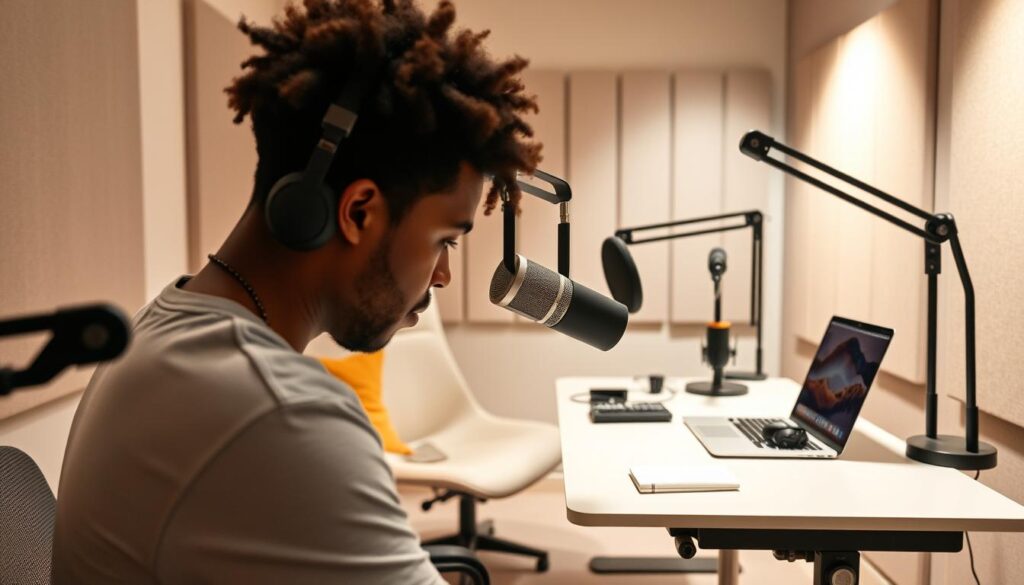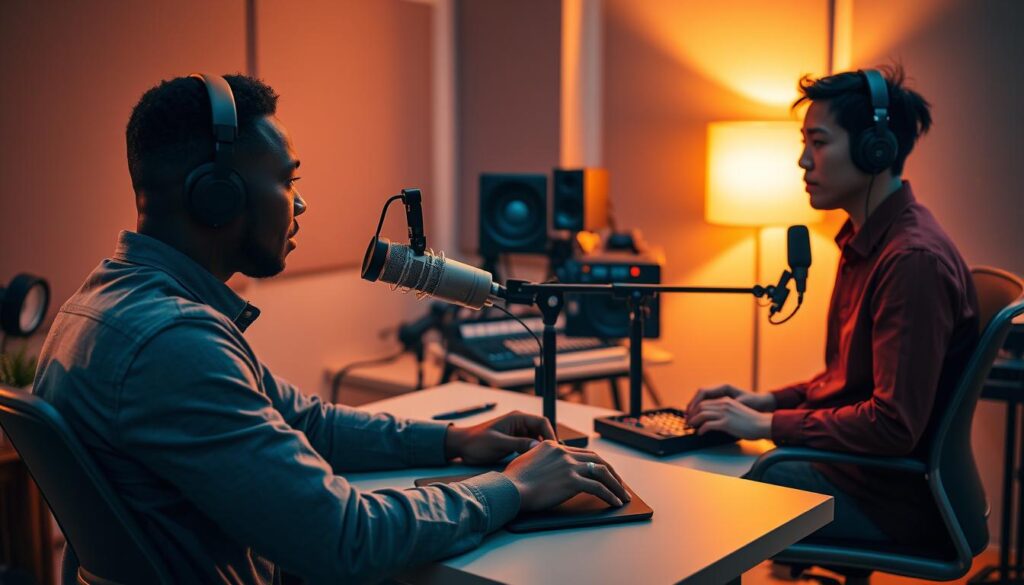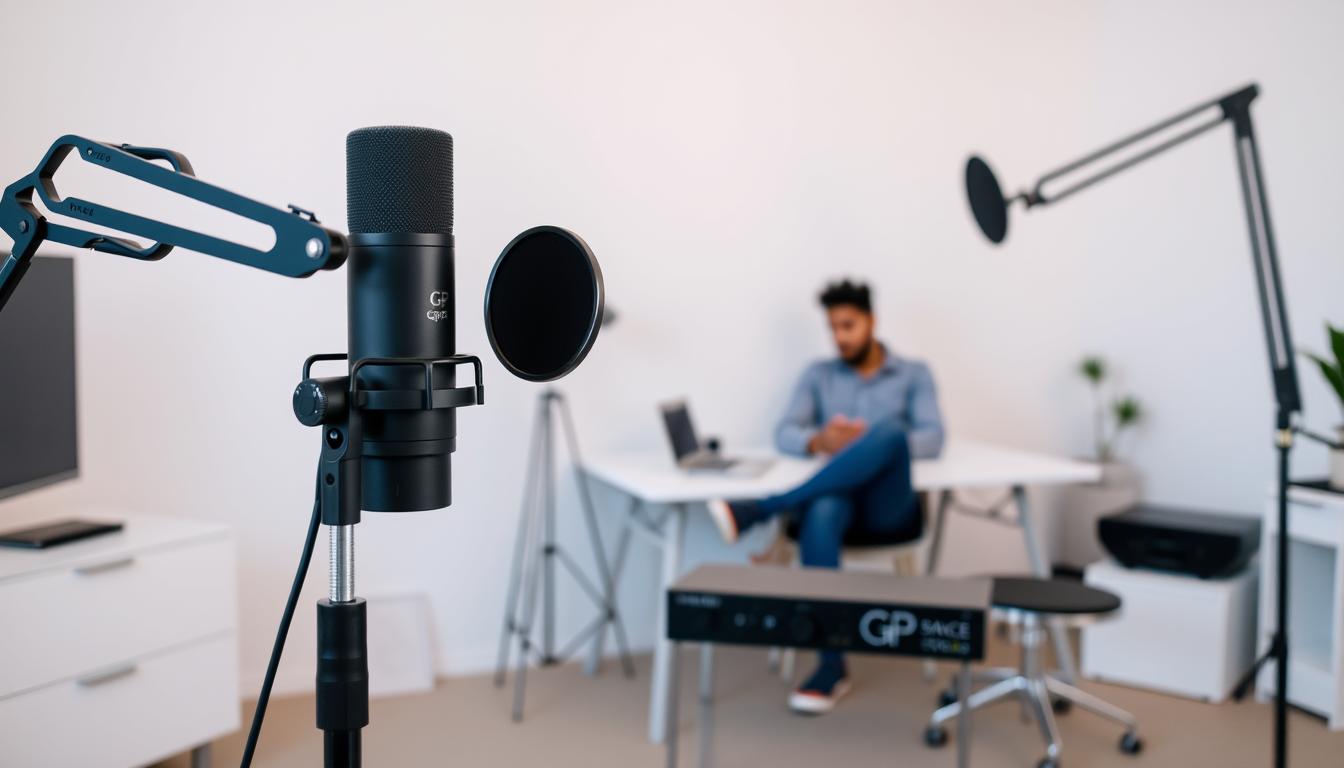Do you think the remote work wave only changed offices? Think again. It’s also reshaping podcasting in big ways. Now, you don’t need a fancy studio to reach people everywhere. If you love to tell stories, have access to the internet, and know the right tips, you’re set. Let’s explore how you can make great podcasts from any place.
Podcasting has broken free from needing a set location. Tools like Riverside help creators get amazing audio and top-notch 4K video, no matter where their guest is. Now, a smartphone lets you record conversations from anywhere, adding pro-level interviews to your lineup. This is great news for anyone living the digital nomad life. So, want to learn to podcast with gear that fits in your bag? We’re here to guide you.
The Evolution of Podcasting: Embracing Remote Possibilities
In the past decade, podcasting has evolved greatly. This is thanks to tech advances and new ways people enjoy media. It started as a small hobby and grew into a worldwide trend. Especially with COVID-19, podcasters had to record interviews from home, which increased their audience.
Using remote tools has made podcasting more global. With apps like Squadcast and Riverside, creators can talk to guests from anywhere. This means listeners get to hear more varied and interesting content from different parts of the world.
Recording interviews remotely has made making podcasts easier. It cuts down on the need for complicated setups. Thanks to new software, creators can spend more time on what they want to say, reaching listeners everywhere easily.
Also, remote interviews can be just as good as studio ones if done right. This keeps remote podcasting popular among creators and listeners. It’s an exciting period for podcasting, as its reach and possibilities keep growing.
Choosing the Right Remote Podcasting Software
For those jumping into podcasting, choosing the right software is key. It shapes your workflow and the audio quality your audience gets. This decision is crucial for creating top-notch podcasts.
Riverside and Squadcast stand out for remote podcasting. Riverside records high-quality audio and video directly on each device. This means your podcast sounds professional, even with a bad internet connection. It’s easy to use and keeps your recordings safe.
Squadcast focuses on simple, clear sound recording. It records hosts and guests separately and combines the tracks. This ensures great sound, no matter the internet connection. It’s perfect for those who want the best audio.
- Riverside: Ideal for reliable, top-quality video and audio. Features like automatic backup add to its reliability.
- Squadcast: Great for those who value simplicity and superior sound. It’s user-friendly with excellent recording quality.
Both options offer easy guest access with a simple link. Choosing Riverside or Squadcast means you can make professional podcasts anywhere, without needing a studio.
Choosing between Riverside and Squadcast depends on your needs. Whether it’s video, simplicity, or sound quality, these tools help. They ensure your podcast reaches many people with clear sound and visuals.
Setting Up Your Remote Podcasting Studio
Setting up the perfect remote podcast studio setup is key for top-notch consistent recording quality. Whether you’re in a calm room at home or in an RV, every part of your studio must work well together. This ensures your podcast is professional and fun to listen to.

Choosing the right location is the first step. Look for a place with little noise. This improves both audio and video. Use high-quality microphones and pop filters for clear sound. Good lighting and a nice background boost the look for video podcasts.
It also helps to know the tech stuff. Riverside.fm is great for quality video and audio. It even works well with different internet speeds. Find more tips here.
Now, let’s talk about some key equipment:
| Equipment Type | Recommendations |
|---|---|
| Microphone | Rode Procaster, Audio-Technica ATR2100-USB |
| Pop Filter | Standard Mesh Material |
| Headphones | Audio Technica ATH-M50x, Various Earbuds |
| Video Camera | Sony HDR-CX405/B, Canon VIXIA HF R800 |
| Podcasting Software | Riverside, Others |
The look and feel of your remote podcasting environment matter a lot. Paying attention to visual and acoustic parts makes your podcast more engaging. It also makes recording easier and more fun for you.
Essential Equipment for High-Quality Remote Podcasting
Stepping into remote podcasting needs the right gear. Think about top-notch microphones, effective pop filters, and dependable headphones. Each item is key to make your sound not just good, but great.
- Microphones: For spaces with lots of noise, dynamic microphones like the Samson Q2U are best. They’re good at blocking out background noise, making sure your voice is clear. For quieter spots, condenser mics are perfect. They catch a wide range of sounds and give your audio a clear quality.
- Pop Filters: Necessary for all microphones, pop filters stop harsh ‘p’ and ‘b’ sounds. This means your audio will sound smoother.
- Headphones: You must have a solid pair of headphones to monitor sound. They let you find any issues in the sound as you record, saving you trouble later.
With top recording software like Squadcast or Riverside, these items lift your production quality and make recording better. They help you create content that connects and holds attention, whether you’re interviewing guests or doing solo talks.
Starting a remote podcast studio might sound tough, but the right equipment makes it exciting. With the finest gear, dive into remote podcasting and see how it changes your audio work.
Maximizing Audio Quality with Minimal Gear
Making your podcast sound amazing on a budget can seem tough. However, with a few key tools, high-quality audio is totally within reach. Let’s explore how to get great sound with just a handful of equipment.
The heart of your setup is the microphone. Choose USB mics like the Samson Q2U or Audio Technica ATR2100 for an affordable yet quality option. These mics are loved for being easy to use and delivering great sound, perfect for podcasters watching their budget.
Adding a pop filter and learning how to place your mic can also make your audio better. These easy steps make sure your voice sounds clear. They help avoid any unwanted sounds in your recordings.
| Equipment | Features | Benefits |
|---|---|---|
| USB Microphones | Plug-and-play, high compatibility | High-quality audio with minimal setup |
| Pop Filters | Reduces plosives, improves clarity | Clearer, more professional sound |
| Microphone Placement Techniques | Correct angle and distance | Optimizes audio capture, minimizes background noise |
By focusing on these important yet affordable tools, you can make your audio sound amazing without spending a lot. Remember, great-sounding podcasts come from using the right tools well, not just spending a lot of money.
Recording Techniques for Engaging Remote Interviews
We understand the high stakes and challenges of remote interviews. Your goals are to improve audio quality and recording methods. This makes your podcast more engaging. Here’s how to make your remote interviews better and clearer.

Start with a detailed pre-interview with your guest. Check their microphone setup to ensure good audio. This stage includes checking positioning, environment, and gear.
- Check and adjust the microphone levels and positioning.
- Minimize background noise by advising on the best possible location for the interview.
- Test and confirm the internet connection speed to avoid disruptions.
During the interview, use advanced recording methods. A mix-minus setup helps prevent audio feedback. Also, using visual signs can make the conversation flow better.
It’s vital to record the chat from both ends. Mac users can use QuickTime and both Windows and Mac users can use Audacity. This way, if you lose connection, you still have your audio.
- Record each side of the conversation locally using reliable software.
- Use visual communication tools to signal transitions or emphasize key points.
Edit carefully with tools like Squadcast or Descript afterwards. These tools let you line up tracks, clean up the audio, and make it sound better. Good editing makes your interview professional and engaging.
By preparing well, using the right tools, and these methods, we make sure our interviews are engaging. They are not just heard, but truly listened to and appreciated.
Remote Podcasting from Anywhere: A Nomad’s Guide
Living as a digital nomad doesn’t mean you have to stop podcasting. In fact, nomadic podcasting has never been easier. With the right mix of passion and tools, you can run a successful podcast from anywhere. Experts like Cindy Scott have mastered podcasting while traveling.
Choosing the right equipment is key. You need stuff that’s easy to carry but still works great. For example, the iRig microphone and sturdy stands won’t take up much room in your bag and still deliver clear sound. Adding good headphones to the mix lets you check your audio anywhere. Also, you must have a good internet connection for digital nomad podcast production. So, picking places where you can get strong internet is essential.
To get set up quickly no matter where you are, here’s a helpful list of the best podcasting tools:
| Gear | Description | Pros | Cons |
|---|---|---|---|
| iRig Microphone | Portable microphone | Compact, High-quality Audio | Sensitive to Handling Noise |
| Adjustable Stand | Collapsible microphone stand | Lightweight, Easy to Set up | May Require Adjustment on Uneven Surfaces |
| Professional Headphones | Over-ear, noise-cancelling headphones | Excellent Sound Isolation | Bulkier than Earbuds |
Using platforms like Squadcast changes the game for podcast production. It lets you interview guests from all over, keeping your show interesting and high quality. By planning ahead and choosing your equipment smartly, your podcast production while traveling won’t just work; it will flourish.
Navigating Challenges: Internet Speeds and Time Zones
When we talk about remote podcasting challenges, internet speed is key. Good internet connectivity affects both how we send and receive podcast content. Whether it’s Zoom, Google Meet, or other services, making sure you have enough internet bandwidth is important. This prevents delays and keeps the sound and picture clear.
Dealing with time zones is another big challenge for podcasters. You need to plan carefully and be ready to adjust. It’s important to talk clearly with guests in different time zones. This way, everyone can join in when they’re ready and full of energy.
- Test your internet speed before you start. Check both download and upload speeds to make sure your broadcast goes smoothly.
- Get the right equipment to support your internet, like ethernet cables for a direct connection, or a strong WiFi 6 router.
- Use tools that adjust for time zones automatically. This helps find times that work for everyone involved.
By facing these remote podcasting challenges, you create a smooth and professional show. Your audience expects it, and your guests deserve it. Keep improving your internet and communicate well. These are the best ways to succeed in the fast-paced podcasting world.
Conclusion
We’ve seen the world of podcasting and how hosting a remote podcast can bring success. It combines using the best tech, having good equipment, and recording well. It’s about sharing your ideas in a way that touches people everywhere and starting conversations that interest the whole world.
Today, with tech always improving, remote podcasting shows our creativity. We use new software and tools to break past limits. It’s now your chance to bring your stories to life and make your mark in the podcast world.
It doesn’t matter if you’re in a big city or under the stars, every challenge helps you get better at remote podcasting. Keep learning, have the right gear, and stay in touch. Here, where new ideas meet new ways of doing things, we encourage you to tell your story. With the right attitude and tools, you can reach everywhere.


